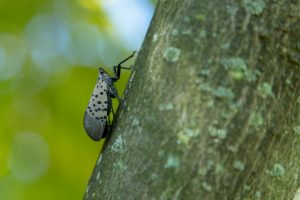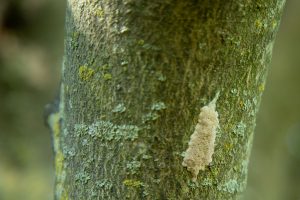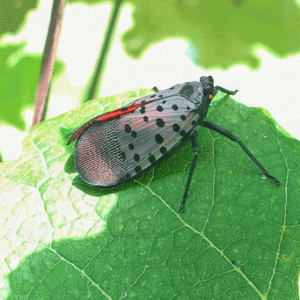Sunday hunting is prohibited on all State Forest property More Info
Treatment Options:
Residents seeking treatment options for spotted lanternfly are encouraged to find a landscape company with an Ornamental and Turf Pesticide license.
Expanded Quarantine:
The Delaware Department of Agriculture has detected and confirmed populations of spotted lanternfly within Sussex County, including Georgetown, Milford, Ocean View, Rehoboth, and Seaford. Due to this recent finding, effective July 12, 2022, the Spotted Lanternfly Quarantine has expanded to include the entire state of Delaware.

The spotted lanternfly, Lycorma delicata, threatens Delaware and the United States. This insect is detrimental to Delaware’s agricultural industries, the environment, and residential areas, and impacts interstate commerce. This insect is a destructive, invasive plant hopper that attacks many hosts, including forests, ornamental trees, orchards, hops, and grapes. In 2017, Delaware was the second state, other than Pennsylvania, to have found the insect. In Delaware, it was first detected in New Castle County, with recent findings in Kent County (October 2020).
The spotted lanternfly is a planthopper native to China, India, and Vietnam, which belongs to the order Hemiptera, family Fulgoridae.
State plant health and forestry officials advise homeowners, businesses, and communities to help identify this pest and tree of heaven, a preferred host, so that you can successfully treat and eradicate these invasive species.

The spotted lanternfly adult is 1” long and 1/2” wide at rest. The forewings are grey with black spots, and the hind wings are red with black spots. The head and legs are black, and the abdomen is yellow with broad black bands. Immature stages are small, round, and black with white spots, and red patches develop as they grow.
Officials believe the spotted lanternfly requires feeding on the tree of heaven (Ailanthus altissima) to reproduce; however, the insect can be found feeding on other plants and trees as well. Egg masses will be laid on the trunk, branches, and limbs of medium to large trees, often in the upper reaches of the canopy. In springtime, nymphs will hatch and move off the trees and search for new hosts, including several crops, including grapes, apples, and peaches.

Susceptible tree species – such as the tree of heaven, walnut, and willow – might develop weeping wounds, leaving a greyish or black trail along the trunk. The spotted lanternfly feeds through the bark using a piercing-sucking mouthpart tapped into the plant like a straw. When it feeds, it excretes honeydew or sugary water on and around its feeding site. This encourages the growth of black sooty mold, which is not harmful to humans but can damage plants and make outside recreation areas unusable. This sap will attract other insects to feed, notably wasps and ants.
Branch dieback, wilting, and plant death are common symptoms of heavily spotted lanternfly feedings.
In late fall, adults will lay egg masses on host trees and nearby smooth surfaces like stone, outdoor furniture, vehicles, and structures. Newly laid egg masses have a grey mud-like covering. Egg masses that have not been covered all the way, are close to hatching or have already hatched will have a segmented look.

The spotted lanternfly is a very distinct insect at both the nymph and adult phases. The egg masses can be hard to spot, making it easy to transport them on vehicles and other outdoor items.
Therefore, Delawareans and visitors need to inspect their vehicles and anything they may be transporting, including trailers, stone, metal, or anything that has spent time outdoors, and remove and destroy any egg masses attached.
Remember, completing a Compliance Checklist and bringing it with you indicates that you inspected and know that no living life stage of spotted lanternfly is present on regulated articles you want to move.
This pest could seriously impact the grape, orchard, hardwood, and nursery and landscape industries if allowed to spread. The insect can also damage high-value ornamentals in home landscapes and affect residents’ quality of life. Due to quarantines in other states, interstate commerce will be impacted if the pest is transported out of the Delaware quarantine area.
Trees and plants that have been known to be affected are:
 Delaware has been working to monitor for spotted lanternfly infestations since Pennsylvania first detected the insect in 2014. Our Plant Industries inspectors have done visual surveys in areas with Tree of Heaven. With the expansion of Pennsylvania’s quarantine to the county level and the proximity of these counties to New Castle County, our inspectors ramped up their inspections, detecting one dead spotted lanternfly in the Wilmington area in 2017.
Delaware has been working to monitor for spotted lanternfly infestations since Pennsylvania first detected the insect in 2014. Our Plant Industries inspectors have done visual surveys in areas with Tree of Heaven. With the expansion of Pennsylvania’s quarantine to the county level and the proximity of these counties to New Castle County, our inspectors ramped up their inspections, detecting one dead spotted lanternfly in the Wilmington area in 2017.
In 2018, our Plant Industries inspectors and USDA staff surveyed the area where the initial detection was found. With the hatching of egg masses and adults present, the population in Delaware grew. Treatment was conducted with homeowners, businesses, and municipalities at various sites.
Along with conducting surveys, our Plant Industries inspectors and USDA contractors have treated more than 23,721 acres with insecticides or herbicides to reduce Delaware’s spotted lanternfly population since the initial quarantine was established in February 2019. This number continues to grow daily. To give perspective on how large and quickly the population of spotted lanternfly can grow, once females began laying egg masses in the Fall of 2021, our team scraped 90,147 egg masses with 30-50 eggs in each by the end of Spring, significantly reducing the next year’s population.
Officials want to eradicate this pest before it spreads, but as a notorious hitchhiker, vigilance is key. The adults will die with a hard frost during the fall and winter months. The egg masses the females lay in the fall will survive the winter and hatch out 30-50 nymphs come late April / early May. Locating and destroying any nymphs in the spring, adults in the summer and fall, and egg masses created in the fall will reduce the population that hatches out next spring.
Emergency Regulations for Spotted Lanternfly
What Does the Delaware Spotted Lanternfly Quarantine Mean?
Delaware Homeowner Spotted Lanternfly and Treatment Fact Sheet Updated: April 9, 2024
Delaware Resident Spotted Lanternfly Quarantine Compliance Checklist
Approved Spotted Lanternfly Chemical Treatment Options Updated April 9, 2024
Delaware Business Spotted Lanternfly Permit Registration and Testing
Delaware Spotted Lanternfly Certificate of Inspection Form for Businesses New!